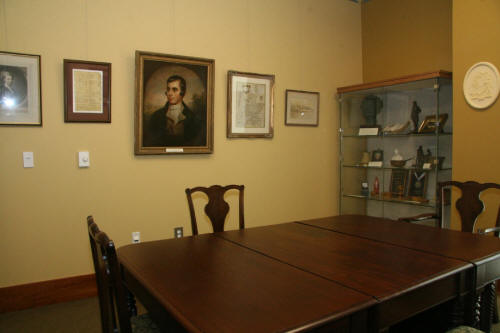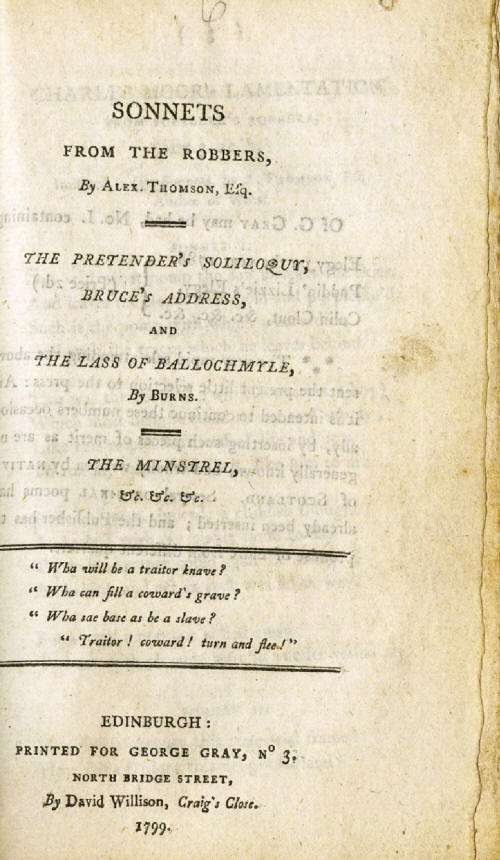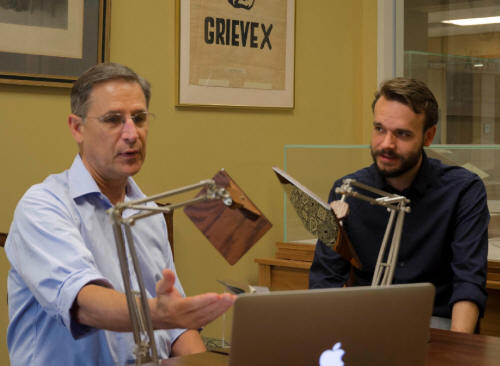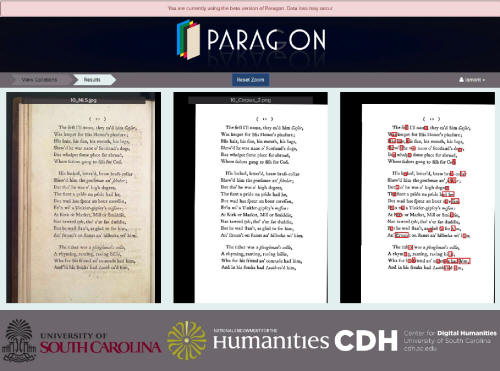|
Edited by Frank R. Shaw, FSA Scot, Greater Atlanta, GA, USA
Email: jurascot@earthlink.net
Craig Lamont is from Glasgow. He earned his
MA and Master of Research degrees at the University of Strathclyde,
moving to the University of Glasgow to work with Prof. Murray Pittock on
his PhD, completed in November 2015. His PhD thesis, titled “Georgian
Glasgow: the city remembered through literature, objects, and cultural
memory theory,” was part of an AHRC-funded collaborative project between
the University and Glasgow Life, which included a major exhibition How
Glasgow Flourished: 1714-1837 at the Kelvingrove Gallery and Museum. In
the fall of 2016, Craig will be teaching in the department of Scottish
Literature at the University of Glasgow.
This is a different type article for Robert Burns Lives!, one like I’ve
never seen before and one which will open up new work by Lamont and
others and hopefully some of our own readers. You will see how they go
about their research by comparing one, two or three copies of previous
original works. I have found the efforts in this brief article to be of
great interest and will add another dimension to the study of Burns for
us all. It is a treat to welcome Craig Lamont to the pages of Robert
Burns Lives! and I look forward to his return in the future.
My thanks to Patrick Scott for the introduction paragraph above on Craig
and for providing me with his article below. (FRS: 9.14.16)
Burns in the heat of the South:
rare books and modern technology
By Craig Lamont
Recently, I was able to make a two-week
visit to the G. Ross Roy Collection of Robert Burns, at the University
of South Carolina. For the past eight months, I have been working on a
new bibliography of the early Burns editions, to update and expand
Egerer’s long-standard work published in 1964. This project is some of
the preliminary research already underway for the later volumes in the
new AHRC-funded Burns edition, headed by Gerard Carruthers. The new
bibliography, which I have written about for the next Burns Chronicle,
is currently focused on the early editions (1706-1802), but it goes
beyond Egerer’s level of description, for instance by providing full
contents lists, showing not just the first time a Burns poem was
published in book form but each time it was included after that.
So far, the research had kept me mostly in
Glasgow, consulting editions in the Mitchell Library and the
University’s own special collections, and then taking trips also to
Alloway to the Birthplace Museum, and, more frequently, to Edinburgh to
the National Library of Scotland. As I learned from studying Elizabeth
Sudduth’s published catalogue, however, the Roy Collection has both a
large number of the early editions and some rarities that are not
available (or extant) in Scotland.

The main library entrance, University of
South Carolina\
I arrived in the middle of July. The
temperature reached 98.6°F (37°C) on the first day, and stayed around
100° for the rest of my stay, with occasional relief from late afternoon
thunderstorms. Suddenly, writing “Burns” under “research topic” on the
library sign-in sheet felt more appropriate than ever. The library
itself is kept cool, and there was a shelf-full of editions ready for me
to begin work. It reminded me of the Glasgow library between semesters:
that eerie silence interrupted by the creak of a centuries-old page,
printed on with centuries-old ink. You might imagine that there is
little left to say about the story of these books, but these early books
invite a different sense of awe from a manuscript, and tell a much
different (sometimes much larger) story. The visit to South Carolina
also allowed me to work directly with Patrick Scott (who is one of the
project advisers) as questions came up, rather than by email as in
previous months. Columbia and the University were more than welcoming.
I’ve felt right at home, despite the consistent appearance of that
unusual simmering object in the sky.

The Roy-Scott Room in Hollings Library,
University of South Carolina
(photo: Robert P. Smith)
The primary purpose of my visit was to
develop and type up bibliographical descriptions for the rare editions
in the Roy Collection. One special item that I had never previously seen
was the second of the “Gray tracts.” In 1799, George Gray, an Edinburgh
bookseller, published two small chapbooks. Egerer hadn’t seen either of
them, but included a description of one, Elegy on the Year Eighty-Eight
(Egerer 37), based on a photo copy sent him by Davidson Cook (Egerer 37,
pp. 58-59). The other one, Sonnets from the Robbers, which includes
“Bruce’s Address” (“Scots wha hae”), doesn’t even have an Egerer number,
though Egerer footnotes a newspaper report that it had once existed.
When Professor Roy found it, there was no other recorded copy, and there
are still only two others reported worldwide.

Sonnets from the Robbers ... Bruce’s Address
(Edinburgh: John Gray 1799)
Image courtesy of the G. Ross Roy Collection, University of South
Carolina Libraries
I also wanted a chance to examine additional
copies of editions I had seen in Scotland, especially where the library
copies I had used first had been rebound or seemed irregular in some
way. In Glasgow, I hadn’t been able to make a side-by-side comparison of
the 1787 copies of Burns Poems with the Belfast and Dublin imprints on
the title page, seeing a Dublin copy in the Mitchell and going across to
Edinburgh to see a Belfast, but the Roy Collection has both. Towards the
end of my first week, for instance, Patrick Scott and I sat down in the
reading room with seven copies of the 1787 Edinburgh edition (Egerer 2;
Roy). Most Burnsians know about the two type-settings for the major
portion of the edition, known from the most famous misprint as the “Skinking:”
and “Stinking” settings, but there are hundreds of other minor variants
between the two (Murdoch), and we were able to assess what kind of
research will be needed in future. Alongside work for the bibliography,
we were able to ask new questions about the story behind these variants.
How much of a role did Burns himself play while the Edinburgh edtion was
being printed and reset? What was the exact relationship between the two
Irish title-pages? My visit seeded questions for future work and let us
begin collaboration on two articles that will look at these questions in
a way that bibliography itself won’t allow (one down, one still to go:
see Scott and Lamont, forthcoming).
There is certainly more than one library where these questions could be
investigated, but the visit to the University of South Carolina let me
get experience with some technology that might help. This kind of
research involves “collation,” or close comparison, in this case of
details from multiple copies of the same edition. In Burns’s time,
printers sometimes made small changes to a page while they were
printing, so that some copies show the first variant and some the
second. (Confusingly, the word “collation” is also used in at least two
other senses, by textual editors for comparison between different
editions and manuscripts, and by bibliographers to describe the way the
sheets of a printed book are folded and assembled to form the finished
volume.) The kind of collation we needed to do for the Burns project is
tedious, and if it is done by simply looking backwards and forwards
between two copies of a book (the so-called “Wimbledon” or “ping-pong”
method), small differences often get overlooked. Over the years,
scholars have developed several optical and digital ways to tackle the
problem.
For the Burns editions, I tried out three different optical “collating
machines” (Smith 2002). These all use a system of mirrors so that the
image from one copy of a book is seen as superimposed over the image of
the same page in another copy, and you can notice even small changes
such as a new comma, apostrophe, or spelling correction. I tried first
with a Lindstand Comparator, a large, desktop, contraption with a
stereoscopic eyepiece like a pair of binoculars, developed by a
professor at South Carolina in the late 1960s, but it is bulky and I
found it tricky to use.
I had better luck with a more recent
invention, Carter Hailey’s Comet. Professor David Lee Miller, a
distinguished colleague of Patrick Scott’s, has a Comet for his research
on Elizabethan editions of Spenser, and he kindly set it up in the
library’s Roy-Scott Room for me to try. The Comet is portable (folded
up, it fits into a small briefcase), and it allows you to compare a
printed book in one library with the digital image on a laptop of a
different copy elsewhere. I tried it out for sample pages from a copy of
the Edinburgh edition and the digitized version (ECCO) available in the
Glasgow library. Like the Lindstrand, the Comet works like a
stereoscope, meaning you need two good eyes, but it doesn’t have an
eyepiece. The mirrors are like anglepoise lamps, so that it takes a
great deal of practice to get them aligned just right, till you can lean
in and get the two pages, one seen with each eye, to merge. However, the
effect is quite impressive when you trick your brain into letting it
happen.

Prof. David Miller demonstrating the Comet,
in the Roy-Scott Room
(photo: John Sawvell)
The third collator I used, the Hinman, is
the oldest but still the gold standard for optical collation. It was
invented in 1946 by Charlton Hinman, who had spent the war in naval
intelligence. The long-running story was that he got his idea from the
way aerial photos were compared before and after bombing raids. The more
recent account is that he adapted the key element from a device that let
astronomers compare successive time-lapse photos of distant galaxies
(Smith, 2000). Hinman himself famously used his invention to collate
fifty-five copies of the Shakespeare first folio, discovering hidden
variants on one page out of every six. Between 1946 and 1979, Hinman and
his collaborator, a retired engineer, manufactured and sold just over
fifty machines, mostly to libraries, but some to pharmaceutical
companies, and probably one to the CIA (don’t ask). The Hinman machine
now at South Carolina (they used to own two) was purchased in 1973.

Craig Lamont comparing two Edinburgh
editions on the Hinman Collator
(photo: John Sawvell)
The Hinman is huge (about six foot high and
five feet across), it’s certainly not portable, and it requires a nearby
electrical outlet. Instead of relying on stereoscopic vision, it
alternates images from the two pages so the differences stand out. Its
accuracy also comes from using permanently aligned mirrors and
eyepieces, and from lighting up the pages being compared. You place the
two copies in the two book-cradles, with the pages held flat by glass
covers, switch on, and line the images up by moving the right-hand
cradle. Then, when you nudge against a lever in the knee-hole, the bulbs
flash intermittently, images of the two pages alternate second by
second, and you see the differences. I found it to be the most effective
of the three collators. It was particularly good in doing comparison of
the two 1787 Irish title-pages, and to my surprise it also worked to
identify variants between the two different settings of the Edinburgh
edition.
What we hadn’t anticipated was the chance to try out a fourth method, a
new digital alternative to the optical machines. Professor Miller is not
only an English professor but also Director of the University’s Center
for Digital Humanities, and he arranged a demo for us of a new software
model, Paragon, that they have been developing for work on the Spenser
project (Miller and Wang). Paragon is an intelligent digital collator
that does much of the work for you, once you have obtained good digital
scans of the texts you want to compare. While there are different kinds
of comparison (pages from two copies, pages from multiple copies against
a single master copy, and so on), for each comparison Paragon produces a
screen of at least three images: one for each original page, and a third
Paragon-made image with red boxes around the differences it has
detected.

Using PARAGON to collate two copies of the
Kilmarnock Burns
Image courtesy of Center for Digital Humanities, University of South
Carolina
After the initial demo, I tried it out with
sample pages from the Kilmarnock copies that had been digitized by
Glasgow and the NLS. Paragon doesn’t interpret what it finds, so if
there is a small ink-smudge, or if one letter has got damaged, on one of
the copies, it picks that “variant” up as “difference.” The differences
highlighted in the right hand image shown here are just that, not the
kind of variants that show Burns making corrections during printing. But
if it picks up differences as small as these, you can bet it will pick
up any actual printing variants—wording or spelling (including
vernacular vs formal spelling), punctuation, misprints that got
corrected midway through printing. It gives you the chance to analyse
the results of something, without having to rely on your ability to see
every difference for yourself. Paragon is a new beginning in collation,
potentially enabling new research into how the Kilmarnock was printed.
With all these new experiences and ideas, I headed back to Scotland. The
original bibliographical project is now almost complete, but the work
has highlighted the potential for a lot more detailed investigation into
the early printing history of individual editions. The last attempt at a
full comparison of variants between the two settings of the 1787
Edinburgh edition appears to have been in 1895, and there seems never to
have been a systematic collation of multiple copies of the 1786
Kilmarnock edition. Getting to use the Comet, the Hinman, and the
preliminary version of Paragon, gives me new ideas about how such
investigation could be done. And if Ross Roy could find a
previously-unrecorded copy of a chapbook that had eluded Egerer, perhaps
another unrecorded Burns pamphlet still lurks awaiting a lucky visitor
on the dusty shelves of some unsuspecting (and one hopes airconditioned)
library.
References
Murdoch, J. Barclay, “The Second Edition of Burns,” Burns Chronicle, 1st
series, 4 (1895), 107-120:
http://www.rbwf.org.uk/digitised-chronicles/
Egerer, J. W., A Bibliography of Robert Burns (Edinburgh: Oliver and
Boyd, 1964; Carbondale, IL: Southern Illinois University Press, 1965).
Lamont, Craig, “The beginning of a new bibliography of Robert Burns
editions,” Burns Chronicle for 2017 (forthcoming).
Miller, David Lee, and Song Wang, “Paragon,” Center for Digital
Humanities, University of South Carolina:
https://sc.edu/about/centers/digital_humanities/projects/paragon.phpARAGON
Roy, G. Ross, “How Many Copies Were Printed of Burns’s Second
(Edinburgh) Edition?,” Robert Burns Lives!, 150 (August 29, 2012), at:
http://www.electricscotland.com/familytree/frank/burns_lives150.htm
Sudduth, Elizabeth, The G. Ross Roy Collection of Robert Burns, An
Illustrated Catalogue (Columbia, SC: University of South Carolina Press,
2009).
Smith, Steven Escar, “’The Eternal Verities Verified’: Charlton Hinman
and the Roots of Mechanical Collation,” Studies in Bibliography, 53
(2000), 129-162.
________________, “’Armadillos of Invention’: A Census of Mechanical
Collators,” Studies in Bibliography, 55 (2002), 133-170.
Scott, Patrick, and Craig Lamont, “The First Irish Edition of Robert
Burns: A Reexamination,” Scottish Literary Review (forthcoming). |
